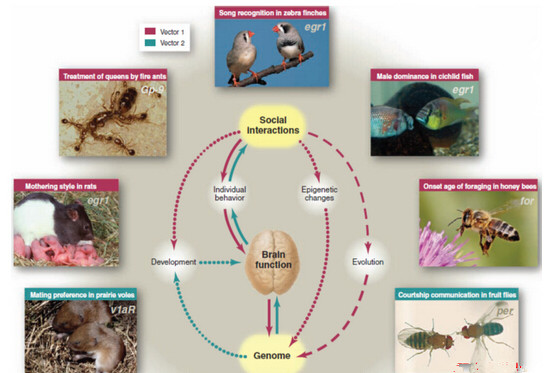 题目内容
(请给出正确答案)
题目内容
(请给出正确答案)
2016年大学生物专业英语期末考试看图作答题2答案
2. Genes, the brain, and social behavior(21分)

汉化图:外围7个小图中每个英文短语的汉化各2分,而图中斜体文字,如egr1、for、v1aR、per等,是相应的基因代号,不用翻译的,共14分;中心图共有7个英文术语,每个汉化各1分,共7分;左上方小图中的英文,不用汉化;本题合计21分
 如果结果不匹配,请 联系老师 获取答案
如果结果不匹配,请 联系老师 获取答案
 题目内容
(请给出正确答案)
题目内容
(请给出正确答案)
2. Genes, the brain, and social behavior(21分)

汉化图:外围7个小图中每个英文短语的汉化各2分,而图中斜体文字,如egr1、for、v1aR、per等,是相应的基因代号,不用翻译的,共14分;中心图共有7个英文术语,每个汉化各1分,共7分;左上方小图中的英文,不用汉化;本题合计21分
 如果结果不匹配,请 联系老师 获取答案
如果结果不匹配,请 联系老师 获取答案
 更多“2016年大学生物专业英语期末考试看图作答题2答案”相关的问题
更多“2016年大学生物专业英语期末考试看图作答题2答案”相关的问题
4. Finding Early Signs of Mad-Cow Disease(5分)
Disease damage: This microscopy image shows brain tissue damaged by Creutzfeldt-Jakob (可不译,照搬) disease. Researchers have made a list of blood proteins that act as early indicators of a group of diseases including bovine spongiform. encephalopathy (BSE), also known as mad-cow disease. The human form. of BSE, a fatal degenerative neurological disorder, called Creutzfeldt-Jakob disease
Biotech pioneer: Leroy Hood, president and cofounder of the Institute for Systems Biology, in Seattle, invented several tools, including the automated DNA sequencer that helped make it possible to sequence the human genome. Now, biotech pioneer Leroy Hood explains how Systems Biology will impact medicine.
将英语短文译为中文
2. Kin Recognition (10分)
Many organisms, from sea squirts to primates, can identify their relatives. Understanding how and why they do so has prompted new thinking about the evolution of social behavior. by David W. Pfennig and Paul W. Sherman Kinship is a basic organizing principle of all societies. Humans possess elaborate means by which to identify relatives, such as using surnames and maintaining detailed genealogies.
Mechanisms for distinguishing kin also occur throughout the plant and animal kingdoms regardless of an organism’s social or mental complexity, in creatures as diverse as wildflowers and wasps. Scientists are beginning to discover that an understanding of the origin and mechanisms of kin recognition offers fresh insights into such diverse topics as how living things choose their mates, how they learn and how their immune system works.
BELDING’S GROUND SQUIRRELS live in groups in which mothers, daughters and sisters cooperate extensively. By using odors, the squirrels can distinguish familiar nestmates, who are close kin, from nonnestmates. They can also discriminate between full sisters and half sisters.
将英语短文译为中文
3 Self-Powered Nanotech (10分)
Nanosize machines need still tinier power plants
By Zhong Lin Wang
The watchmaker in the 1920s who devised the self-winding wristwatch was on to a great idea: mechanically harvesting energy from the wearer’s moving arm and putting it to work rewinding the watch spring.
Today we are beginning to create extremely small energy harvesters that can supply electrical power to the tiny world of nanoscale devices, where things are measured in billionths of a meter. We call these power plants nanogenerators. The ability to make power on a minuscule scale allows us to think of implantable biosensors that can continuously monitor a patient’s blood glucose level, or autonomous strain sensors for structures such as bridges, or environmental sensors for detecting toxins — all running without the need for replacement batteries. Energy sources are desperately needed for nanorobotics, microelectromechanical systems (MEMS), homeland security and even portable personal electronics. It is hard to imagine all the uses such infinitesimal generators may eventually find.
In Brief
★Nanotechnology has huge potential — but those minuscule devices will need a power source that is better than a battery.
★ Waste energy, in the form. of vibrations or even the human pulse, could provide sufficient power to run such tiny gadgets.
★ Arrays of piezoelectric nanowires could capture and transmit that waste energy to nanodevices.
★ Medical devices will likely be a major application. A pacemaker’s battery could be charged so it would not need replacing, or implanted wireless nanosensors could monitor blood glucose for diabetics.
1. “The Nobel Prize in Physiology or Medicine 2004”Press Release(15分)
4 October 2004
The Nobel Assemblyat Karolinska Institutet has today decided to award The Nobel Prize in Physiology or Medicine for 2004 jointly toRichard Axel and Linda B. Buckfor their discoveries of "odorant receptors and the organization of the olfactory system"
Summary
The sense of smell long remained the most enigmatic of our senses. The basic principles for recognizing and remembering about 10,000 different odours were not understood. This year's Nobel Laureates in Physiology or Medicine have solved this problem and in a series of pioneering studies clarified how our olfactory system works. They discovered a large gene family, comprised of some 1,000 different genes (three per cent of our genes) that give rise to an equivalent number of olfactory receptor types. These receptors are located on the olfactory receptor cells, which occupy a small area in the upper part of the nasal epithelium and detect the inhaled odorant molecules.
Each olfactory receptor cell possesses only one type of odorant receptor, and each receptor can detect a limited number of odorant substances. Our olfactory receptor cells are therefore highly specialized for a few odours. The cells send thin nerve processes directly to distinct micro domains, glomeruli, in the olfactory bulb, the primary olfactory area of the brain. Receptor cells carrying the same type of receptor send their nerve processes to the same glomerulus. From these micro domains in the olfactory bulb the information is relayed further to other parts of the brain, where the information from several olfactory receptors is combined, forming a pattern. Therefore, we can consciously experience the smell of a lilac flower in the spring and recall this olfactory memory at other times.
Richard Axel, New York, USA, and Linda Buck, Seattle, USA, published the fundamental paper jointly in 1991, in which they described the very large family of about one thousand genes for odorant receptors. Axel and Buck have since worked independent of each other, and they have in several elegant, often parallel, studies clarified the olfactory system, from the molecular level to the organization of the cells.